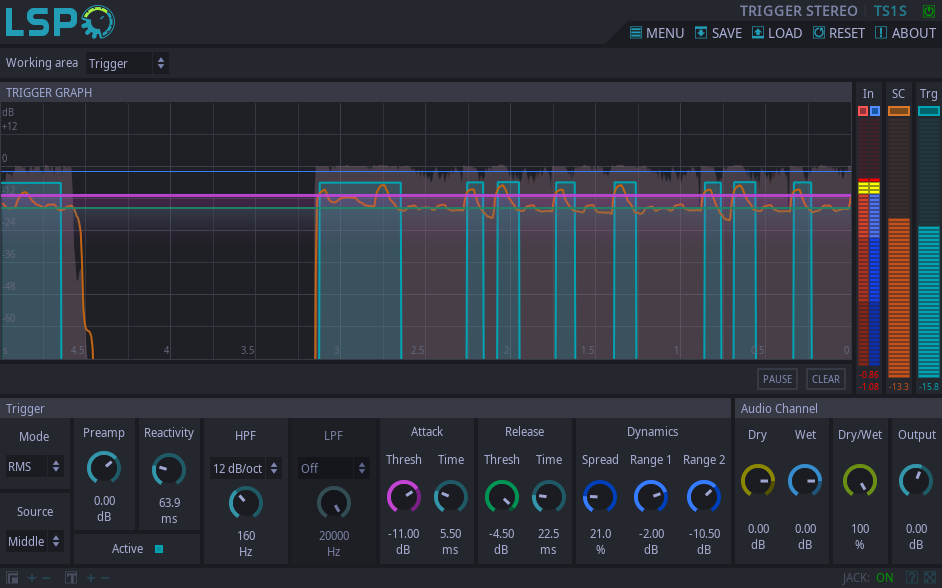Trigger Stereo

Detailed: LSP Trigger Stereo (TS1S)
Formats: CLAP, JACK, LV2, VST2, VST3
Categories: Dynamics
Developer: Vladimir Sadovnikov
Description:
This plugin implements trigger with mono input and mono output. There are up to eight samples available to play for different note velocities.
Controls:
- Bypass - hot bypass switch, when turned on (led indicator is shining), the plugin does not affect the input signal.
- Workspace - this control allows to switch the UI between trigger mode and instrument configuration mode.
- Pause - pauses any updates of the trigger graph.
- Clear - clears all graphs.
- Mix - show dry/wet mix control overlay.
- In L, R - enables drawing of input signal graph and corresponding level meter.
- SC - enables drawing of sidechain graph and corresponding level meter.
- Trg - enables drawing of trigger signal graph and corresponding level meter.
'Trigger' section:
- Preamp - input signal amplification for the sidechain.
- Mode - combo box that allows to switch different modes for sidechain. Available modes are:
- Peak - peak mode
- RMS - root mean square of the input signal
- LPF - input signal processed by one pole low-pass filter
- SMA - input signal processed by SMA (Simple Moving Average) filter
- Source - part of the input signal to use for sidechain processing:
- Middle - middle part of signal is used for sidechain processing
- Side - side part of signal is used for sidechain processing
- Left - only left channel is used for sidechain processing
- Right - only right channel is used for sidechain processing
- LPF - allows to set up slope and cut-off frequency for the low-pass filter applied to input signal.
- HPF - allows to set up slope and cut-off frequency for the high-pass filter applied to input signal.
- Active - trigger activity indicator.
- Reactivity - the reactivity of the sidechain.
- Attack level - the minimum level of the sidechain signal that forces trigger to trigger.
- Attack time - the time gap used by the trigger to prevent false note-on detection.
- Release level - the maximum level (relative to Attack level) of the sidechain signal that forces trigger to shut down.
- Release time - the time gap used by the trigger to completely turn off after the signal becomes lower than Release level.
- Dynamics spread - this knobs allows to add some dynamics to output signal.
- Dynamics range 1, Dynamics range 2 - the bounds of the range that allows to translate trigger level into velocity.
'Samples' section:
- Sample # - the selector of the current displayable/editable sample.
- Head cut - the time to be cut from the beginning of the current sample.
- Tail cut - the time to be cut from the end of the current sample.
- Fade in - the time to be faded from the beginning of the current sample.
- Fade out - the time to be faded from the end of the current sample.
- Makeup - the makeup gain of the sample volume.
- Pre-delay - the time delay between the MIDI note has triggered and the start of the sample's playback.
- Listen - buttons that plays or stop preview of selected sample.
'Sample matrix' section:
- Enabled - enables/disables the playback of the corresponding sample.
- Active - indicates that the sample is loaded, enabled and ready for playback.
- Velocity - the maximum velocity of the note the sample can trigger. Allows to set up velocity layers between different samples.
- Pan Left - the panorama of the left audio channel of the corresponding sample.
- Pan Right - the panorama of the right audio channel of the corresponding sample.
- Listen - the button that plays preview of the corresponding sample.
- Stop - the button that stops preview of the sample preview.
- Note on - indicates that the playback event of the corresponding sample has triggered.
'Audio channel' section:
- Output gain - the overall output gain of the plugin.
'Dry/Wet' mix control overlay:
- Dry - the gain of the input signal passed to the audio inputs of the plugin.
- Wet - the gain of the processed signal.
- Dry/Wet - the knob that controls the balance between the mixed dry and wet signal (see Dry and Wet) and the dry (unprocessed) signal.































